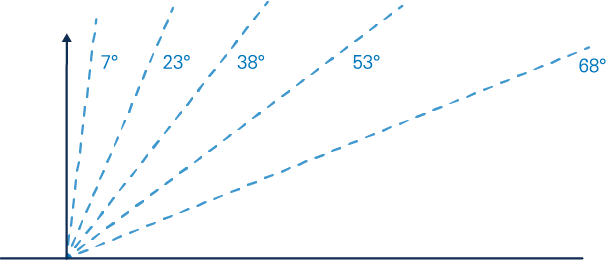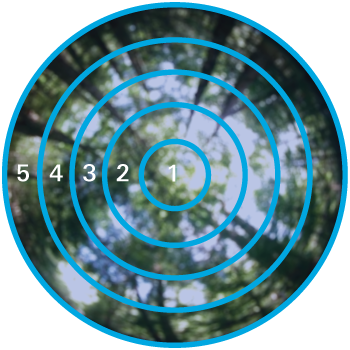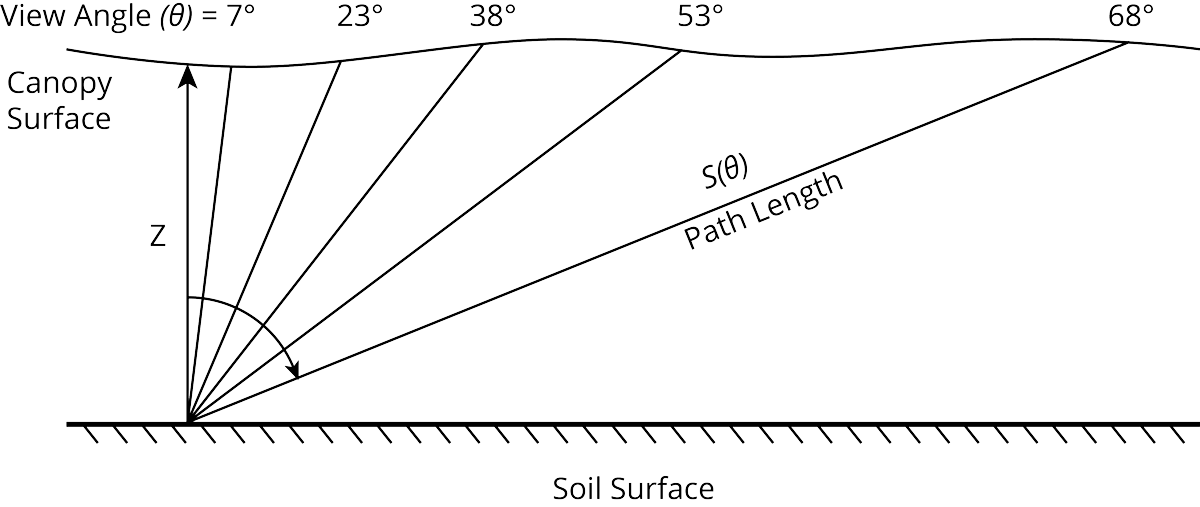Science
Theory of Operation
Calculating Leaf Area Index (LAI) with the LAI-2200C requires certain assumptions about the plant canopy. This allows accurate measurements without the need to destructively sample the canopy. The LAI-2200C relies upon four assumptions: all light is absorbed by the foliage, the foliage is randomly distributed, the foliage orientation is random, and the foliage elements are limited by the view ring.
No real canopy conforms exactly to these assumptions. Foliage is never random, but is clumped along stems and branches, and is not "black." Many species exhibit some degree of heliotropism, which violates the azimuthal randomness assumption. However, many canopies can be considered random, and living foliage does have low transmittance and reflectance below 490 nm. Also, it is now possible to correct for errors caused by any transmittance or reflectance that does affect readings.
Offsetting errors are common, such as when leaves are grouped along stems (transmittance higher than the random model). In practice, most violations of the assumptions can be overcome with the proper measurement technique, and the model still works well even if all the assumptions are not met exactly.

All light is absorbed by the foliage
It is assumed that the below-canopy readings do not include radiation that has been reflected or transmitted by foliage. Note: this assumption is removed when you apply scattering corrections, thus accounting for foliage reflectance and transmittance in post-processing.

Foliage is randomly distributed
These envelopes might be parallel tubes (a row crop), a single ellipsoid (an isolated bush), an infinite box (turf grass), or a finite box with holes (deciduous forest with gaps).

Foliage orientation is random
That is, it does not matter how the foliage is inclined, but the leaves should be facing all compass directions.
Foliage elements are limited by the view ring
This is ensured when the distance from the optical sensor to the nearest foliage element, such as a leaf, is at least four times the element width.
Calculating Leaf Area Index
Leaf Area Index (LAI) is the ratio of foliage area to ground area. The LAI‑2200C computes LAI from measurements made above the canopy and below the canopy, which are used to determine canopy light interception at 5 angles. These data are fit to a well-established model of radiative transfer inside vegetative canopies to compute leaf area index, mean tilt angle, and canopy gap fraction.
The optical sensor of the LAI‑2200C consists of a fisheye lens and an optical system. The fisheye lens "sees" a hemispherical image, which the optical system focuses onto the photodiode optical sensor, which is made up of five concentric rings.


Gap Fractions
The gap fraction technique is at present the most powerful and practical tool available for indirect sensing of canopy structure. It can be applied not only to continuous canopies, but also to discrete foliage-containing envelopes, such as row structure or individual trees.
Canopy structure information, including amount and orientation of foliage, can be estimated from measurements of gap fractions.
The gap fraction of a canopy is the fraction of view in some direction from beneath a canopy that is not blocked by foliage. The fractional sunfleck area is equivalent to the gap fraction in the solar direction.
Download journal articleLight Scattering Correction
One of the traditional underlying assumptions of the LAI‑2000 and LAI‑2200 has been that foliage absorbs all the radiation in the blue waveband seen by the sensor (320-490 nm). This is usually a good assumption under diffuse light conditions such as uniform overcast, just before sunrise, or just after sunset. In direct sunlight, however, reflectance off foliage causes a much greater overestimation of the gap fraction and underestimation of leaf area index.
References
- Anderson, R. S. 1971. Radiation and crop structure. In: Plant Photosynthetic Production. Manual of Methods. (eds Z. Sestak, J. Catsky, and P. G. Jarvis). W. Junk, The Hague. pp 412-466.
- Anderson, R. S., D. R. Jackett, J. L. B. Jupp. 1984a. Linear functionals of the foliage angle distribution as tools to study the structure of plant canopies. Aust. J. Bot. 32: 147-156.
- Anderson, R. S., D. R. Jackett, J. L. B. Jupp, J. M. Norman. 1984b. Interpretation of and simple formulas for some key linear functionals of the foliage angle distribution. Agric. and For. Meteor. 36: 165-188.
- Bonhomme, R. and Chartier, P. 1972. The interpretation and automatic measurement of hemispherical photographs to obtain sunlit foliage area and gap frequency. Isr. J. Agric. Res. 22: 53-61.
- Chen, X. and Campbell, G.S. 1988. Microprocessor controlled instrument for measuring transmitted PAR and sunfleck fraction in plant canopies. Paper presented at American Society of Agronomy, Anaheim.
- Kobayashi, H., Ryu Y., Baldocchi, D.B.,Welles, J.M., Norman, J.M. (2013) On the correct estimation of gap fraction: How to remove scattered radiation in gap fraction measurements? Ag. and For. Meteorology, 174-175: 170-183.
- Lang, A. R. G., Y. Xiang, and J. M. Norman. 1985. Crop structure and the penetration of direct sunlight. Agric. and For. Meteor. 37: 229-243.
- Lang, A. R. G. and Y. Xiang. 1986. Estimation of leaf area index from transmission of direct sunlight in discontinuous canopies. Agric. and For. Meteor. 37: 229-243.
- Lang, A. R. G. 1986. Leaf area and average leaf angle from transmittance of direct sunlight. Aust. J. Bot. 34: 349-355.
- Lang, A. R. G. 1987. Simplified estimate of leaf area index from transmittance of the sun’s beam. Agric. and For. Meteor. 41: 179-186.
- Leblanc, S. G., Chen, J. M., Fernandes, R., Deering, D. W., Conley, A., 2005. Methodology comparison for canopy structure parameters extraction from digital hemispherical photography in boreal forests. Agric. and For. Meteor. 129: 187–207.
- Miller, J. B. 1963. An integral equation from phytology. J. Aust. Mat. Soc. 4: 397-402.
- Miller, J. B. 1967. A formula for average foliage density. Aust. J. Bot. 15: 141-144.
- Nilson, T., 1999. Inversion of gap frequency data in forest stands. Agric. and For. Meteor. 98–99: 437–448.
- Nilson, T., and A. Kuusk. 2004. Improved algorithm for estimating canopy indices from gap fraction data in forest canopies. Agric. and For. Meteor. 124: 157–169.
- Norman, J. M. and G. S. Campbell. 1989. Canopy structure. In: R. W. Pearcy, J. Ehlringer, H. A. Mooney, and P. W. Rundel (eds) Plant Physiological Ecology: Field Methods and Instrumentation. Chapman and Hall, London and New York, pp 301-325.
- Perry, S. G., A. B. Fraser, D. W. Thomson, and J. M. Norman. 1988. Indirect sensing of plant canopy structure with simple radiation measurements. Agric. and For. Meteor. 42: 255-278.
- Philip, J. R. 1965. The distribution of foliage density with foliage angle estimated from inclined point quadrat observations. Aust. J. Bot. 13: 357-366.
- Ross, J. 1981. The radiation regime and architecture of plant stands. W. Junk. The Hague, 391 pp.
- Ryu, Y., T. Nilson, H. Kobayashi, O. Sonnentag, B. E. Law, & D. D. Baldocchi. 2010. On the correct estimation of effective leaf area index: Does it reveal information on clumping effects? Agric. and For. Meteor. 150, 463-472.
- Van Gardingen, P. R., Jackson, G. E., Hernandez-Daumas, S., Russell, G., Sharp, L., 1999. Leaf area index estimates obtained for clumped canopies using hemispherical photography. Agric. and For. Meteor. 94 (3–4), 243–257.
- Walker, G. K., R. E. Blackshaw, and J. Dekker. 1988. Leaf area and competition for light between plant species using direct sunlight transmission. Weed Technology 2: 159-165
- Warren Wilson, J., and J. E. Reeve. 1959. Analysis of the spatial distribution of foliage by two-dimensional point quadrats. New Phytol. 58: 92-101.
- Welles, J. M. 1990. Some indirect methods of estimating canopy structure. In: J. Norman and N. Goel (eds) Instrumentation for studying vegetation canopies for remote sensing in optical and thermal infrared regions. Harwood Academic Publishers GmbH, London.
- Welles, J. M. and J. M. Norman. 1991. Instrument for indirect measurement of canopy architecture. Agron. J. 83: 818-825.
- Welles, J.M. and Cohen, S. 1996. Canopy structure measurement by gap fraction analysis using commercial instrumentation. Journal of Experimental Botany, 47: 1335-1342.
Applications
Continue Reading






